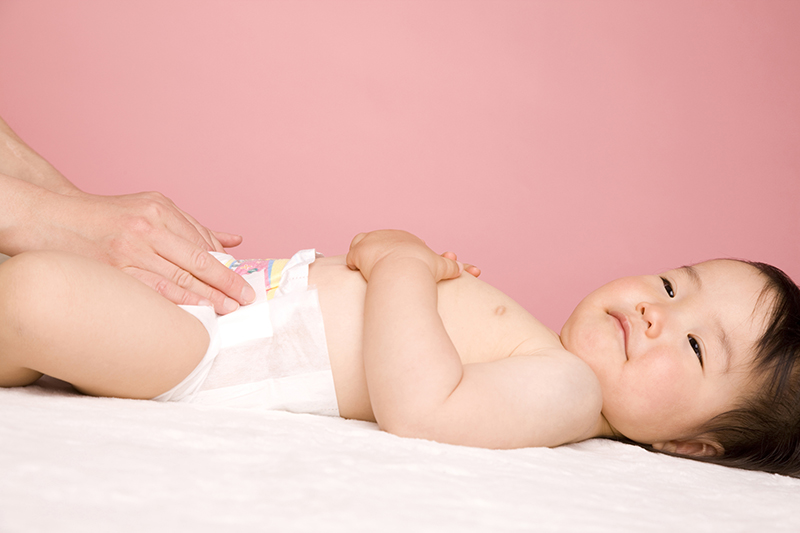Families For Life | Nappy Rash-Newborn

Diaper rash is common and can happen no matter how careful you are about looking after your baby’s bottom. Almost all children who wear diapers get diaper rash at some stage.
Causes of diaper rash
Many things can combine to cause diaper rash in your child.
The main cause is wearing a wet or dirty diaper for too long. Prolonged dampness, friction and ammonia substances released from urine can irritate your child’s skin.
Plastic pants often make diaper rash worse because they stop air circulating normally and keep the diaper area damp.
Soaps and detergents left on cloth diapers after washing can also contribute to diaper rash.
Sometimes children also have other conditions such as eczema, psoriasis, thrush or impetigo, which might make diaper rash worse.
Symptoms of diaper rash
The skin on your child’s bottom will look red and sore. Sometimes diaper rash might go up onto your child’s tummy or spread up towards your baby’s back. Some areas of skin might be raised or swollen, and there might be breaks in the skin. These breaks are called ulcers.
The skin folds aren’t usually affected because urine doesn’t get into them.
The rash can cause discomfort and pain, which can make your baby irritable.
When to see a doctor about diaper rash
You should take your child to the General Practitioner (GP) if:
the rash hasn’t improved after three days, even when you use the treatment steps below
blisters, crusts or pimples appear
your child is upset and isn’t sleeping
your child has an unexplained fever
the rash is spreading
the end of your son’s penis is red and swollen, or has a scab on it.
Diaper rash treatment
Simple measures are often the best. Diaper rash will usually get better or go away within a few days of taking the following steps.
Change your baby’s nappies frequently
Frequent diaper changes keep the diaper area dry and give your child’s skin a chance to heal. Check your child every hour or so to see if his diaper is wet or soiled. Change wet or soiled diapers straight away.
Let your baby’s bottom ‘air’
Give your baby’s bottom some air for as long as possible every day. You can leave baby lying on an open diaper or a towel (naked from the waist down) even while she’s sleeping. You can also try fastening her diaper loosely, to allow air to circulate freely.
Clean your baby’s skin
Use lukewarm water and a mild soap to wash your baby’s skin. Rinse the skin thoroughly and gently pat him dry with a towel. Use running water to clean your baby where possible.
If you’re using disposable wipes, make sure they don’t contain alcohol or other irritants, which will sting and irritate the raw areas on your baby’s skin. Also, some babies might be allergic to the preservatives in disposable wipes.
Use an appropriate protective cream after each diaper change
Apply a simple cheap barrier cream thickly with every change. You can get these creams from a supermarket or a pharmacy without a prescription.
Talcum-based powders aren’t recommended for diaper rash, because accidentally breathing in a puff of talcum powder can cause breathing difficulties in babies.
Rinse cloth diapers thoroughly after they’re washed
This gets rid of soap residue in your baby’s diaper. Bleach is most effective for killing bacteria, but make sure to rinse the diapers well in fresh water after using bleach-based detergents. Ensure the diapers are quite dry before using them again.
Avoid plastic overpants if you’re using cloth diapers.
Medications
For severe diaper rash or diaper rash that won’t go away with simple measures, your doctor might recommend using cortisone creams or ointments (hydrocortisone 1%). Creams containing steroid medication should be used only after you’ve talked to your doctor. Always follow the instructions on the packet when putting these creams on your baby.
Your doctor might also prescribe particular creams or ointments if your baby has a secondary infection with bacteria or thrush.
It isn’t clear whether cloth or disposable diapers are better at preventing diaper rash. The most important thing is to change a wet or dirty diaper straight away. Many parents prefer to use disposable diapers for a bad case of diaper rash, then go back to cloth diapers once baby’s skin has healed.
Complications of diaper rash
It takes weeks for your baby’s skin to repair itself, so her skin will be more vulnerable to things that irritate it.
Secondary infections such as thrush (fungus or yeast) can happens. Thrush looks like bright red, shiny areas in the diaper area. These red areas have clearly defined borders. Thrush can also affect the skin folds. Lots of red dots or pustules (satellite lesions) might appear beyond the outer edge of the rash.
Treat thrush with an antifungal cream prescribed by your doctor. Thrush can take longer to clear than regular diaper rash and often comes back. Treatment can take a long time, which can be frustrating.
Diaper rash prevention
Always keep your child’s diaper area clean and dry. Change your child’s diaper frequently and give his bottom air as often as you can.
Protective barrier creams can help keep your child’s skin in good condition.
© raisingchildren.net.au, translated and adapted with permission
Explore more